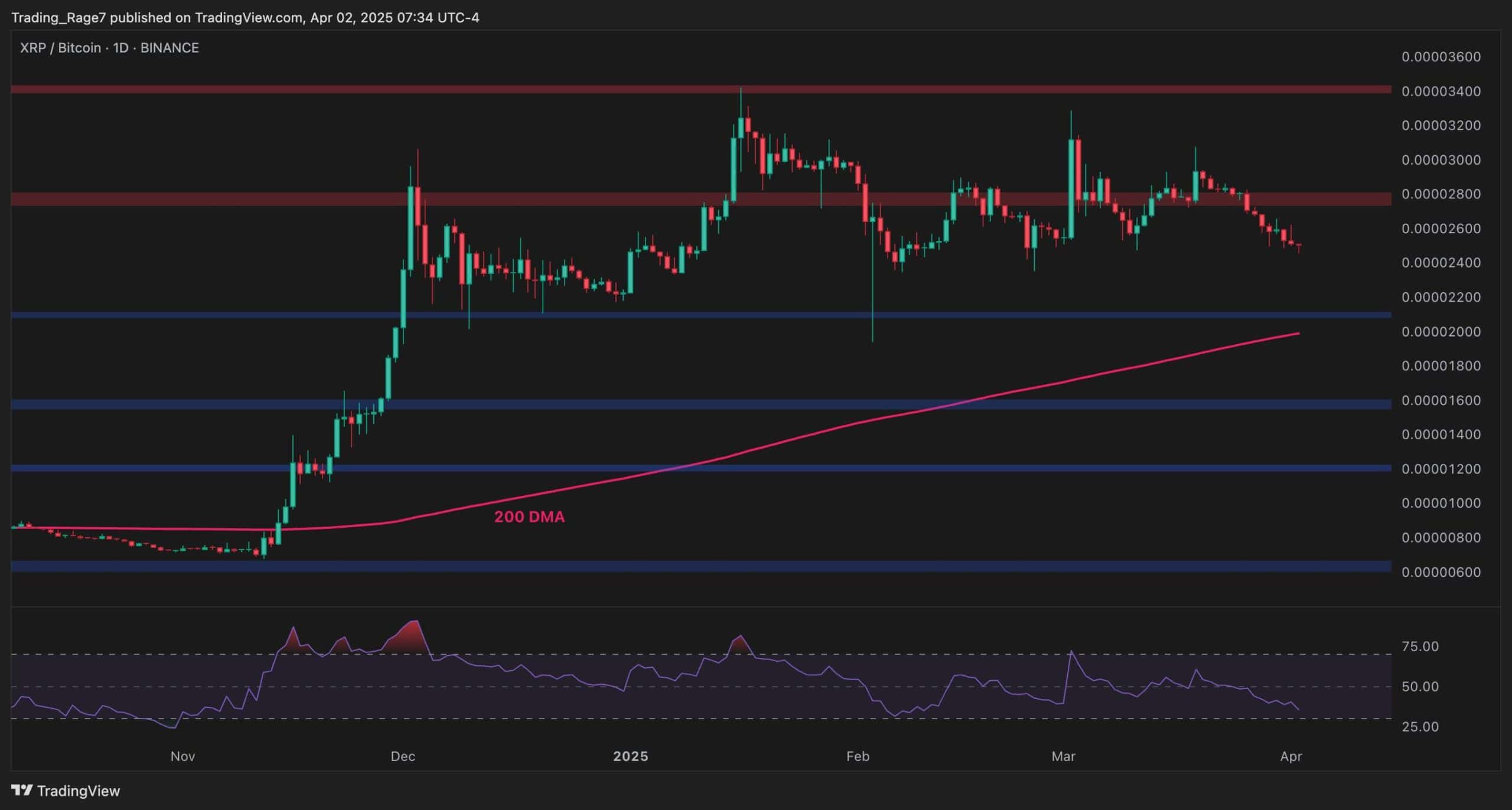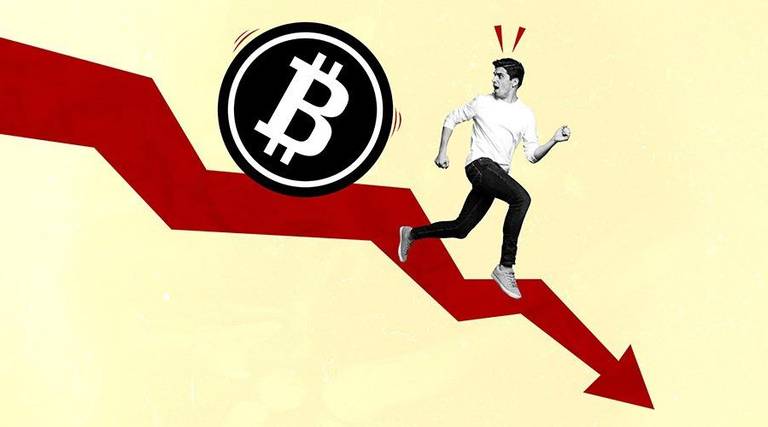
XRP is holding above key support on both USD and BTC pairs but remains under pressure, with no strong bullish momentum in sight. Price action is consolidative and leaning slightly bearish in the short term. By Edris Derakhshi The USDT Paired Chart On the USDT pair, XRP is currently hovering above the $2 support zone after a series of lower highs following the rejection from the $3.00 resistance area. The asset has yet to make a higher high since mid-February and continues to face selling pressure on each attempt to rally. The 200-day moving average is rising steadily and currently sits well below the price near the $1.80 mark, acting as dynamic support for now. The RSI is also drifting near the 40–45 zone, suggesting weakening momentum without being fully oversold. If the buyers fail to defend the $2, the price may quickly slide toward the next demand around $1.50. On the other hand, to shift sentiment, XRP needs to reclaim $2.5 and close firmly above it. The BTC Paired Chart The XRP/BTC pair has been consolidating after a strong rally in November last year, with the price currently trading around 2,500 SAT. The pair has faced resistance near 3,000 SAT, which has led to the recent pullback. The 200-day moving average at approximately 2,000 SAT remains intact, indicating that, similar to the USDT pair, the broader uptrend is still in play. Yet, the RSI is trending lower, suggesting a potential weakening of momentum, but as long as XRP holds above 2,000 SAT, a bullish continuation above the 3,000 SAT area could be expected. The post Ripple Price Analysis: How Long Will XRP’s Consolidation Last? appeared first on CryptoPotato .
Crypto Potato
You can visit the page to read the article.
Source: Crypto Potato
Disclaimer: The opinion expressed here is not investment advice – it is provided for informational purposes only. It does not necessarily reflect the opinion of BitMaden. Every investment and all trading involves risk, so you should always perform your own research prior to making decisions. We do not recommend investing money you cannot afford to lose.
Bybit Recovers Strongly from February Hack as Capital Inflow Soars in March

Bybit has made a remarkable turnaround after suffering a high-profile hack in February. Its capital inflow in March was nothing short of impressive. Data from DeFiLlama shows that Bybit’s capital inflow in March reached an astonishing $3.61 billion, the highest among all centralized exchanges (CEXs) for the month. This, obviously, is a significant recovery for the platform and a testament to probably effective crisis management. 1. Retrieving lost capital after a hack is a difficult task for any exchange. 2. Most hacked exchanges tend to either collapse completely or exist in a zombie state. 3. Even the hacked CEX in question (in this case, Bybit) has managed to hang on to a fair amount of customer trust. 4. This article will explore the implications of Bybit’s recovery. After a tough few weeks following the hack, Bybit is coming back strong. The hack was bad, of course—the breach in security that led to the theft of user funds was never going to be an easy thing to deal with. But if a company can manage a life-threatening event and come out strong on the other side, there will surely be many Bybit loyalists living in a world where they can feel normal again. And with Bitcoin and other cryptocurrencies surging, Bybit may very well be back in play. Bybit’s Recovery Plan: Transparency and Asset Reserves After the hack, Bybit took immediate and decisive action to manage the crisis. One of the key aspects of Bybit’s recovery strategy was its commitment to being transparent. The exchange quickly shared detailed updates with its users about the situation and the steps being taken to rectify the breach. In an effort to ensure that customer funds were fully protected, Bybit emphasized something very important—its asset-sharing—a concept that corresponds 1:1 with every user deposit. This was, for a good number of users, a very reassuring communication strategy. Bybit shared updates, gave some specialized interviews, and kept on communicating. This was almost a “overcommunication” strategy—lots of users who might have been teetering on the edge of returning to the site got this honesty as a confidence boost. Besides transparency, Bybit prioritized recovering the stolen funds. The security team at the company worked day and night tracing the pilfered assets and collaborating, where necessary, with authorities to identify the bad guys. This effort also helped with user reassurance. Moreover, Bybit took proactive measures to manage the fallout from the hack by supervising 350,000 withdrawal requests that had built up during the uncertain time. The handling of this situation allowed users who wanted to access their funds to do so quickly and without extra hassle. Going into damage control mode with this process helped Bybit fix its reputation enough to concentrate on the recovery from the breach. DeFiLama shows that after being hacked in February, Bybit`s capital inflow in March reached $3.61 billion, ranking first among all CEXs, indicating that its customers are returning after the hack. Binance`s inflow in March was $3.545 billion, ranking second. Currently, the total… pic.twitter.com/mstyw3SZ13 — Wu Blockchain (@WuBlockchain) April 1, 2025 March Inflow: A Strong Showing from Bybit Bybit’s successful recovery was most clearly illustrated in March when the exchange saw a whopping influx of capital. With $3.61 billion in capital inflow, Bybit led all centralized exchanges, even ahead of Binance, which saw an inflow of $3.545 billion in the same time frame. The fact that Bybit managed to attract this enormous amount of new capital, in spite of the hack it experienced earlier in the year, is a pretty strong testament to the platform’s resilience and the way it has managed to reassure its users. Bybit has total capital inflows of $15.133 billion—indicative of both its recovery and continued growth. Those figures suggest that not only is the user base returning, but there’s renewed trust in operations and security. Given the volatile nature of the crypto space and the heightened risks associated with exchange hacks, Bybit’s performance (in capital inflows, at least) is all the more impressive. Binance’s Strong Position Amid Bybit’s Recovery Even though Bybit had impressive inflows in March, it wasn’t the only exchange experiencing that trend. Binance, the world’s largest cryptocurrency exchange, also had a strong inflow of $3.545 billion in March, landing it in second place, just behind Bybit. This suggests that, despite the competition from exchanges like Bybit, users still trust Binance and are sending it a significant amount of capital. Trust in centralized exchanges appears to be growing, as evidenced by the large inflows seen by both Binance and Bybit in March. These inflows occurred just months after a significant security breach at Bybit, yet they indicate an intrinsic, upward trust trend for both platforms. This upward trust trend underscores the ability of both platforms to maintain user confidence, even when strong evidence points to possible, user-destroying security vulnerabilities in the places where users hold their crypto. The space between the two platforms is made clear by the finding that, in fact, there is no space—the ability of the two platforms to maintain confidence just might be a `crypto` manager’s textbook illustration of how to handle a breach, by being open and transparent. Looking Ahead: A Competitive Landscape The competitive structure of the centralized exchange market is changing while Bybit recovers from the hack. Binance and Bybit are both doing very well, yet Bybit’s sharp recovery is a clear sign that it is not only back but also looking to capture market share. If the platform can keep improving its fortifications and maintain a fundamentally sound, super transparent way of dealing with user troubles, that’s a good sign for it in terms of strength, stability, and position in the market. Additionally, the March data sheds light on the user trust in the cryptocurrency exchange ecosystem. Exchanges that offer not just innovative products and services but also the security and transparency users demand will likely be the ones that thrive in the long run. Bybit’s recovery serves as a model for how exchanges can bounce back from such security incidents, with a laser focus on asset reserves, clear and concise communication with users, and a quick response to user needs. The market is changing. How other world exchanges will adapt to the increasing demand for safe, easy-to-use platforms remains to be seen. But today, Bybit’s impressive resurgence makes it about as close to a guaranteed thing as you can get in this market. It is a testament to the platform’s resilience and the regained trust of the platform’s user base. Disclosure: This is not trading or investment advice. Always do your research before buying any cryptocurrency or investing in any services. Follow us on Twitter @nulltxnews to stay updated with the latest Crypto, NFT, AI, Cybersecurity, Distributed Computing, and Metaverse news ! Crypto Potato

Justin Sun Offers $50 Million Reward to Recover $456 Million in Funds Linked to TRON
In a recent livestream on April 3rd, crypto entrepreneur Justin Sun unveiled a substantial initiative aimed at recovering lost assets within the cryptocurrency sphere. Sun announced that he will extend Crypto Potato











